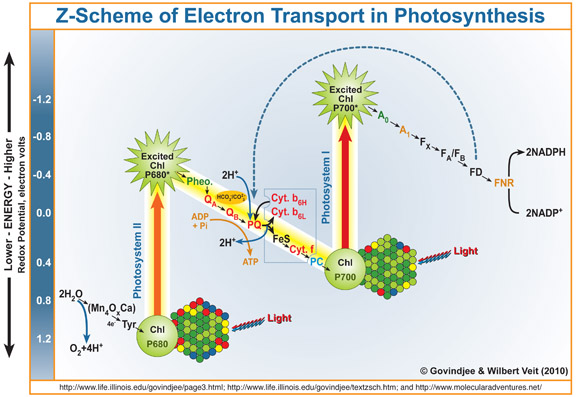

Z-Scheme of Electron Transport in Photosynthesis. by Govindjee and Wilbert Veit, 2010 (gov@illinois.edu). The electron transport from H2O to nicotinamide adenine dinucleotide (NADP+) is traced from left to right on the diagram that uses two Photosystems (I and II). This process is initiated by the simultaneous absorption of light by two antenna complexes, represented by clusters of colored balls. The absorbed energy is then transferred to the reaction center chlorophylls (Chl) P680 and P700 and this powers the entire process. (Mn40xCa) is the manganese center, a complex containing 4 manganese atoms, which participates in the splitting of two water molecules into 4 protons (4H+), 4 electrons (4e–) and one oxygen molecule (O2). Tyr is a redox active tyrosine molecule, also sometimes referred to as Yz or simply as Z, which acts as an intermediate between the manganese center and “reaction center” of Photosystem II, PSII (P680), a chlorophyll (Chl) complex. Excited P680* has the energy of the photon, that was captured by and transferred to it from its light-gathering antenna complex (cluster of colored balls). Pheo is pheophytin, a chlorophyll with its central magnesium ion (Mg2+) replaced by two protons; it is the primary electron acceptor of PSII, whereas P680* is the primary electron donor. QA is a plastoquinone, which is tightly bound and immovable. It is also known as the primary stable electron acceptor of PSII, and it accepts and transfers one electron at a time. QB is a loosely bound plastoquinone molecule which accepts two electrons and two protons; HCO3– (bicarbonate) and CO32– (carbonate) play an essential role here. QBH2, reduced QB, then detaches, and becomes mobile, shuttling the 2 electrons and 2 protons within the hydrophobic core of the thylakoid membrane to the cytochrome b6/f complex (blue rectangle). FeS is the Rieske iron-sulfur protein. Cyt f is cytochrome f. Cyt.b6L and Cyt.b6H are two cytochrome b6 molecules (of lower and higher potentials) which participate in the Q cycle. PC is plastocyanin, a highly mobile copper protein. P700 and Excited P700* are Chls in the reaction center of Photosystem I in the ground and excited energy state, respectively. AO is a special chlorophyll a molecule that is the primary electron acceptor of PSI, whereas P700* is the primary electron donor of PSI. A1 is a phylloquinone (vitamin K) molecule. FX, FA and FB are three separate immobile iron sulfur protein centers. FD is ferredoxin, a mobile iron sulfur protein, which can participate, along with other iron sulfur centers, in cyclic transport (dashed blue line). FNR is the enzyme ferredoxin-NADP oxidoreductase, which enables NADP+ to accept two electrons and a proton and become NADPH, the reduced form of NADP+. The overall process concentrates protons into the thylakoid lumen, producing an energy gradient that is used in the production of ATP from ADP and inorganic phosphate (Pi) via ATP synthase.